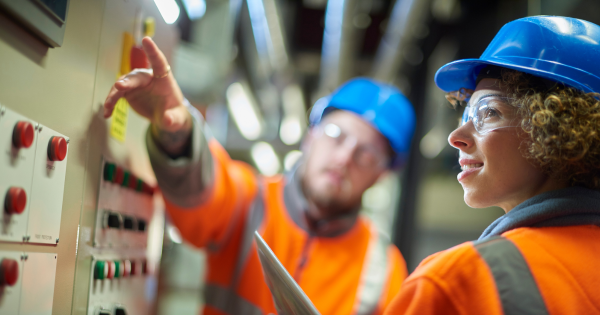Manufacturing organizations are facing the requirement of reducing their carbon footprint and CO2 emissions level, especially in Europe, where the regulatory landscape is accelerating quickly.
To understand where companies are, and which challenges they are facing along this journey, IFS ran a roundtable event with over 13 France-based C-level executives, mostly representing large multinational companies. We spoke to the likes of CFOs, COOs, Heads of Decarbonization, Digital Transformation Directors and Members of Board.
A New Era: ESG and the Next Normal
As one of our attendees noted as a conversation starter, “Since Covid, everything has changed. For us this means more restrictions, new perspectives but also more opportunities for and in the supply chain.”
In many instances, the crisis and its far-reaching global effect, has indeed accelerated pre-existing trends towards achieving and reporting on ESG performance.
In more recent months, the reporting landscape has started tightening up, especially in Europe, where the Corporate Sustainability Reporting Directive (CSRD) will expand on and revise the EU’s Non-Financial Reporting Directive (NFRD). The Directive will require companies to create a sustainability report through the European Sustainability Reporting Standards (ESRS) annually, with electronically readable and searchable reports, starting in 2025.
The pandemic has certainly advanced the strategic case for sustainable investment, and our conversations revealed that most companies already have initiatives underway, with a growing interest in visibility and traceability of supply chains, including the ability to better understand scope 3 emissions.
An interesting question that came up was whether in the short-term, the new CSRD rules could hamper the competitiveness of companies, whereas in the medium- to long-term, such regulatory pressure could help create more sustainable value.
The Data Problem
Many of our conversations revolved around scope emissions data: how to collect it, process it, and the ability to understand it in the right way. As one head of decarbonization noted, “It’s very complex to collect all relevant data from the various data sources and populate legal reports that require hundreds of KPIs.”
While calculating scope 1 and 2 emissions is relatively straight forward as it is owned and controlled by companies and uses a manageable number of calculation methods, scope 3 data is where it gets more complex.
Considering that a substantial portion of emitting activities falling under scope 3 for manufacturers, calculating emissions across the 15 different categories, each with its own calculation methods and reliance on external data, can be a laborious task.
While many calculation methods yield less-than-ideal accuracy and actionability, they serve as a good starting point for organizations that are at the early stage of the decarbonization journey. One executive noted, “For us at the moment, scope 3 emissions do not need to be accurate, so as long as the numbers are consistent towards reporting. We can improve accuracy over time.”
New Business Models are Needed
“Can we integrate new business models that include sustainability?” was a question that highlighted the fact that manufacturers will need to eventually replace their current ways of operating with sustainability embedded into the end-to-end process, starting with the design of the product where a large degree of environmental impact can already be determined and influenced.
An attendee from a discrete manufacturing company shared the success the company has had with a new business model that offers ‘second life’ electronics to customers deliberately interested in refurbished or remanufactured products, as they contribute to accounting for a lower total carbon footprint compared to brand-new products.
In some other industries, most emissions occur during the product process itself, such as in the cement industry, where the burning of limestone, which is required for the process, releases a high degree of carbon dioxide. One of our attendees representing this industry explained, “We are trying to reduce carbon emissions in many other ways, but the limestone issue will require new technologies that can drive greater outcome.” The company has started looking into the capturing of carbon from the cement stack and storing it deep underground.
Pioneering such carbon capture technologies could potentially help remove CO2 emissions permanently, and more importantly, isolate and convert them into marketable industrial products.
Bottom line: companies are increasingly recognizing that (such) new transformational business models are not only a source of innovation but also have the potential to drive greater competitiveness and talent retention/attraction.
What is the Role of Technology in all this?
Although the solution to this global problem is complex, broad, and will evolve for generations to come, what is certain is that technology will play a pivotal role in all this.
One attendee representing a major transport manufacturer shared how their digital innovation team had developed a digital twin technology to be able to carry out maintenance operations remotely, eliminating the need to travel.
Technology may not offer a magic bullet solution per se; however it will enable companies to increase productivity, efficiency, and cost savings, reduce waste, resources and perhaps most importantly, analyze and track progress.
In addition to that, the technology supply market will not only be able to provide software but also expertise, skills, and insights at a time where the majority of manufacturers lack the right internal digital and green skills.
As one attendee put it, “Finding the right talent is incredibly difficult nowadays, especially when it comes to data and lifecycle analysis (LCA) skills.”
Going forward, companies will need to invest in developing new green skillsets around areas including resource efficiency, sustainable product and process design, decarbonization, and many other areas.
Conclusion: They Key Is to Keep Going, regardless of where you are
Many companies have already started on their decarbonization journeys and agree that the topic will only grow. Our observation was that French companies are very much attuned to country-specific regulations and initiatives, and in some cases, this success inspires and motivates other regions, business units, etc.
One attendee from a multinational manufacturer stated: “France is where we are driving most of our sustainability initiatives and it’s also our second most profitable market.” This is evidence to the fact that a more responsible and greener business can also be profitable as it drives far greater efficiencies and opens itself to more innovation and collaboration by default.
One thing is for sure: there is no “one size fits all” approach, each journey is different, however the key is to keep going, to fail, but invest more, and most importantly, learn to collaborate across the value chain. Only a collaborative ecosystem approach can improve transparency, accuracy, and accessibility of emissions data, which is vital in the decarbonization journey.
SOURCE: Slowik, M. (2024, February 9). The Road to Decarbonization in Manufacturing: Challenges and Opportunities ahead. IFS Blog. https://blog.ifs.com/2024/02/the-road-to-decarbonization-in-manufacturing-challenges-and-opportunities-ahead/

